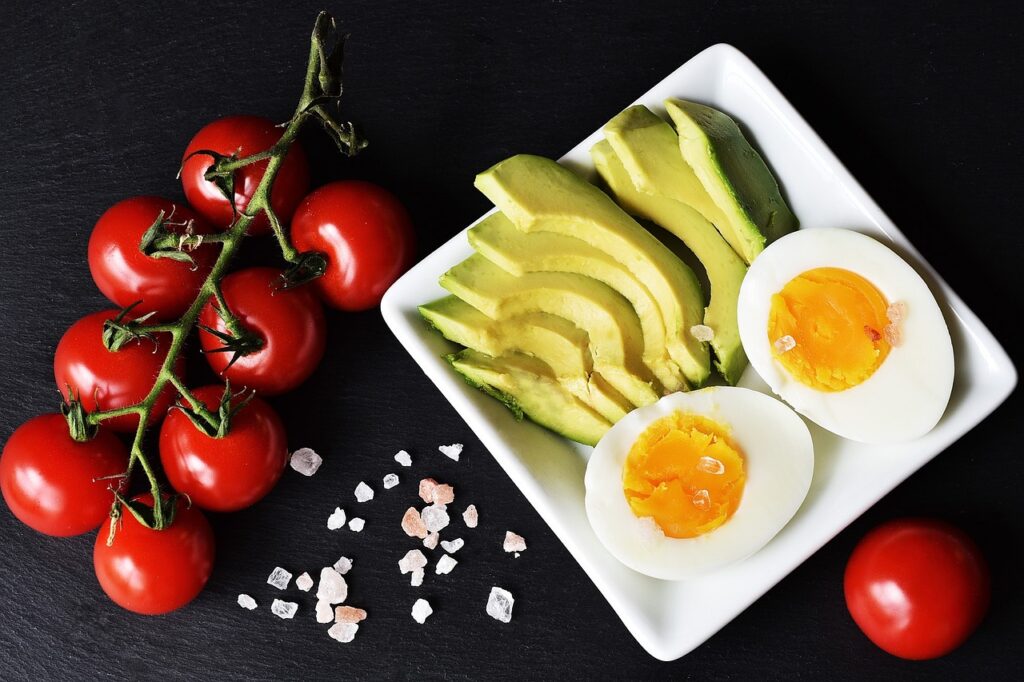Are you a vegetarian on a keto diet who loves starting your day with a refreshing smoothie? If so, you're in luck! We have compiled a list of 14 keto smoothie tips specifically tailored to suit your dietary needs.
From choosing the right low-carb fruits and vegetables to incorporating healthy fats and protein sources, these tips will help you create delicious and nutritious smoothies that align with your vegetarian keto lifestyle.
But that's not all; there are some surprising ingredients and hidden carb pitfalls to be aware of, so keep reading to discover all the secrets to crafting the perfect keto smoothie for vegetarians.
Choose Low-Carb Fruits and Vegetables

To ensure that your keto smoothie remains low in carbohydrates, it's important to carefully choose fruits and vegetables that are also low in carbs. While many fruits and vegetables are healthy choices for a regular diet, some may contain higher levels of carbohydrates that can hinder your weight loss goals on a keto diet. However, there are plenty of low-carb fruit alternatives that you can incorporate into your smoothie recipes for weight loss.
When it comes to fruits, berries are your best bet. Berries such as strawberries, raspberries, and blackberries aren't only delicious but also low in carbs. They're packed with antioxidants and fiber, making them a great addition to your keto smoothies. Avocado is another excellent fruit option for a low-carb smoothie. It's high in healthy fats and low in carbs, making it a perfect choice for those following a keto diet.
In terms of vegetables, leafy greens like spinach and kale are ideal for your keto smoothies. They're low in carbs and high in nutrients, adding a refreshing taste and a boost of vitamins to your smoothies. Additionally, cucumber and zucchini are great low-carb vegetable options that can be added to your smoothies for extra hydration and a mild flavor.
Incorporate Healthy Fats Into Your Smoothies
Consider adding a generous serving of healthy fats to elevate the nutritional value of your keto smoothie.
Incorporating healthy fats into your smoothies is essential for vegetarian keto options. While fruits and vegetables are the foundation of a keto smoothie, healthy fats provide the necessary energy and satiety.
Avocado is a popular choice, as it adds a creamy texture and is packed with monounsaturated fats, which are beneficial for heart health. You can also use coconut oil or full-fat coconut milk to increase the fat content. These options provide medium-chain triglycerides (MCTs), which are easily converted into energy by the body.
Another way to incorporate healthy fats is by adding nuts or seeds, such as almonds, walnuts, or chia seeds. These options provide a good source of omega-3 fatty acids, which are important for brain health.
Additionally, nut butters like almond butter or peanut butter can be used to enhance the flavor and increase the fat content of your smoothie. Remember to measure the quantities to ensure you're staying within your desired macronutrient ratio.
Use Unsweetened Plant-Based Milk as a Base

Using unsweetened plant-based milk as a base is a great way to create a creamy and nutritious keto smoothie for vegetarian dieters. Not only does it add a smooth and velvety texture to your smoothie, but it also provides a good source of healthy fats and essential nutrients.
Plant-based milk options such as almond milk, coconut milk, and hemp milk are all low in carbs and high in healthy fats, making them ideal for a keto diet.
One of the benefits of using unsweetened plant-based milk for keto smoothies is that it adds creaminess without adding a lot of carbs. Regular milk contains lactose, which is a type of sugar and can increase the carb content of your smoothie. Unsweetened plant-based milk, on the other hand, is typically low in carbs and can help you stay within your keto macros.
When choosing the best unsweetened plant-based milk for keto smoothies, it's important to consider the carb content and ingredients. Look for options that are labeled as unsweetened and have no added sugars. Additionally, read the ingredient list to ensure there are no hidden sugars or artificial additives. Some brands even offer unsweetened plant-based milks specifically formulated for keto diets, which can be a convenient option.
Incorporating unsweetened plant-based milk as a base in your keto smoothies not only adds creaminess but also provides essential nutrients and healthy fats. By choosing the right plant-based milk, you can create delicious and satisfying keto smoothies that align with your vegetarian lifestyle.
Opt for Low-Carb Sweeteners
When it comes to sweetening your keto smoothie, there are a few low-carb options to consider. Natural sugar alternatives like Stevia and Monk Fruit can provide sweetness without adding significant carbs.
Additionally, sugar alcohols like erythritol and xylitol can be used sparingly to add sweetness to your smoothie while keeping the carb count low.
Experiment with these low-carb sweeteners to find the right balance that suits your taste preferences and keto goals.
Natural Sugar Alternatives
For vegetarian dieters following a keto lifestyle, incorporating natural sugar alternatives that are low in carbohydrates can be a beneficial choice. When it comes to natural sweetener options, there are a few that stand out for their health benefits and low carb content.
Stevia is a popular choice among keto dieters because it contains zero calories and has no effect on blood sugar levels.
Another option is erythritol, a sugar alcohol that has minimal impact on blood sugar and insulin levels.
Monk fruit extract is also a great choice as it contains zero calories and has no effect on blood sugar.
Stevia and Monk Fruit
To incorporate low-carb sweeteners into your keto smoothies, consider using stevia and monk fruit as healthier alternatives to regular sugar. These natural sweeteners have gained popularity in the keto community for their zero-calorie and low-carb properties.
Here are the pros and cons of using stevia and monk fruit:
- Stevia:
- Pros: Stevia is derived from the stevia plant and is up to 200 times sweeter than sugar. It has no impact on blood sugar levels and is considered safe for most people.
- Cons: Some people find stevia to have a slightly bitter aftertaste, and it may not work well in certain recipes where sugar is essential for texture.
- Monk Fruit:
- Pros: Monk fruit extract is derived from the monk fruit and is also intensely sweet without any impact on blood sugar levels. It has a more natural taste compared to stevia.
- Cons: Monk fruit extract can be more expensive than other sweeteners, and it may not be as readily available in all stores.
When incorporating stevia and monk fruit into baking recipes, it's important to note that they're much sweeter than sugar. Start with small amounts and adjust to taste. Additionally, you may need to make adjustments to other ingredients to maintain the desired texture and structure of the baked goods.
Sugar Alcohol Options
Now let's explore the sugar alcohol options as low-carb sweeteners for your keto smoothies.
Sugar alcohol alternatives can be a great way to manage sugar cravings while still adhering to a ketogenic diet.
One popular option is erythritol, which is a sugar alcohol that contains zero net carbs and has a minimal impact on blood sugar levels. It's also well-tolerated by most people and doesn't cause digestive issues like other sugar alcohols.
Another option is xylitol, which has a similar sweetness to sugar and can be used in equal amounts. However, it's important to note that xylitol does contain some net carbs, so it should be used in moderation.
Add a Protein Source to Your Smoothies
Consider incorporating a plant-based protein powder into your keto smoothies for a nourishing boost of nutrients. Protein is an essential macronutrient that helps build and repair tissues, supports muscle growth, and promotes satiety. By adding protein to your smoothies, you can create a more balanced and satisfying meal option.
Here are three alternative protein sources you can explore:
- Hemp protein powder: Derived from hemp seeds, this protein powder is rich in essential amino acids, omega-3 fatty acids, and fiber. It has a mild, nutty flavor and blends well with various ingredients.
- Pea protein powder: Made from yellow peas, pea protein powder is highly digestible and allergen-friendly. It's a complete protein source, providing all essential amino acids. It has a neutral taste, making it versatile for smoothie recipes.
- Soy protein powder: Soy protein is derived from soybeans and is a complete protein source. It contains all essential amino acids and is particularly rich in isoflavones, which have been associated with various health benefits. Soy protein powder has a mild flavor and can be easily incorporated into smoothies.
Adding a protein source to your keto smoothies not only enhances their nutritional value but also helps meet your daily protein requirements. Experiment with different protein powders to find the one that suits your taste and dietary needs.
Include Leafy Greens for Added Nutrients

To boost the nutrient content of your keto smoothies, be sure to include leafy greens.
Leafy greens such as spinach, kale, and Swiss chard are packed with vitamins, minerals, and antioxidants that are essential for a healthy diet.
Adding a handful of these greens to your smoothies won't only enhance their nutritional value but also provide a refreshing and vibrant taste.
Nutrient-Rich Leafy Greens
Including leafy greens in your keto smoothie can provide a nutrient-rich boost to your vegetarian diet. These powerful greens are packed with essential vitamins, minerals, and fiber that support overall health.
Here are three alternative greens that you can incorporate into your keto smoothies:
- Spinach: Spinach is a versatile leafy green that blends well with other ingredients. It's rich in iron, calcium, and vitamin K, which are essential for strong bones and healthy blood.
- Kale: This superfood is a nutritional powerhouse, loaded with vitamins A, C, and K. It also contains antioxidants and fiber, promoting digestive health and reducing inflammation.
- Swiss chard: With its vibrant colors and mild flavor, Swiss chard is a great addition to your keto smoothie. It's an excellent source of magnesium, potassium, and vitamin C, supporting heart health and immune function.
Variety of Smoothie Options
For a variety of smoothie options that include leafy greens for added nutrients, try blending different combinations of fruits, vegetables, and leafy greens to create delicious and nutritious keto smoothies. By experimenting with various ingredients, you can discover creative flavor combinations that suit your taste preferences.
Incorporating leafy greens like spinach, kale, or Swiss chard into your smoothies not only adds a vibrant color but also boosts the nutritional value. Leafy greens are rich in vitamins A, K, and C, as well as minerals like iron and calcium. They also provide dietary fiber, which aids in digestion and helps you feel full for longer.
Some popular combinations include spinach and pineapple, kale and berries, or Swiss chard and mango. Don't be afraid to get creative and try different combinations to keep your smoothies interesting and packed with nutrients.
Experiment With Different Flavors and Spices
Expand your palate and elevate your keto smoothie game by exploring a wide array of flavors and spices. Adding different flavor combinations and spices to your smoothies not only enhances their taste but also provides various health benefits.
Here are three exciting ways to experiment with flavors and spices in your keto smoothies:
- Citrus Burst: Squeeze some fresh lemon or lime juice into your smoothie for a refreshing citrus twist. Citrus fruits are rich in vitamin C and antioxidants, which support immune health and help fight inflammation.
- Spicy Kick: Add a pinch of cayenne pepper or a dash of ginger to your smoothie for a spicy kick. These spices are known for their metabolism-boosting properties and can aid in digestion.
- Sweet and Savory: Try incorporating herbs like basil or mint into your smoothies for a unique flavor combination. These herbs not only add freshness but also offer antioxidant and anti-inflammatory benefits.
Experimenting with different flavors and spices in your keto smoothies allows you to create a variety of taste sensations while reaping the health benefits they provide. So, don't be afraid to get creative and step out of your comfort zone when it comes to flavoring your smoothies. Your taste buds and your body will thank you.
Don't Forget About the Importance of Hydration

To optimize your keto smoothie experience, it's essential to prioritize hydration. Staying hydrated is important for overall health and can enhance the benefits of your keto diet. When following a low-carb diet like keto, your body produces fewer insulin hormones, which can lead to increased urination and potential dehydration. Therefore, it becomes crucial to replenish the lost fluids and maintain proper hydration levels.
Drinking an adequate amount of water throughout the day is essential for staying hydrated. Additionally, incorporating hydrating foods into your smoothies can also help meet your hydration needs. Adding ingredients like coconut water, cucumber, celery, or even a splash of unsweetened almond milk can provide hydration while keeping your smoothie low in carbs.
Another way to ensure optimal hydration is to monitor your water intake. Aim to drink at least eight glasses of water per day, or more if you're physically active or live in a hot climate. Remember to listen to your body's signals for thirst and make a conscious effort to reach for water regularly.
Prioritizing hydration while enjoying your keto smoothies won't only enhance the taste and texture of your drinks but also support your overall well-being. So, don't forget to drink up and stay hydrated throughout your keto journey.
Make Your Smoothies More Filling With Fiber-Rich Ingredients
Boost the satiety factor of your keto smoothies by incorporating fiber-rich ingredients. Fiber is an essential nutrient that promotes feelings of fullness and aids in digestion. By adding fiber to your smoothies, you can create a more filling and satisfying meal or snack.
Here are three fiber-rich ingredients you can include in your smoothie recipes:
- Chia Seeds: These tiny seeds are packed with fiber, antioxidants, and omega-3 fatty acids. When soaked in liquid, chia seeds form a gel-like substance that adds thickness and creaminess to your smoothie. They also help regulate blood sugar levels and promote a healthy digestive system.
- Flaxseeds: Similar to chia seeds, flaxseeds are rich in fiber and omega-3 fatty acids. They can be ground and added to your smoothies, providing a nutty flavor and a boost of nutrition. Flaxseeds are also known for their ability to support heart health and reduce inflammation.
- Leafy Greens: Vegetables like spinach, kale, and Swiss chard are excellent sources of fiber. Adding a handful of leafy greens to your smoothie not only increases its fiber content but also provides vitamins, minerals, and antioxidants. These greens can help improve digestion, support weight management, and enhance overall health.
Incorporating these fiber-rich ingredients into your smoothie recipes can help you feel fuller for longer and support your overall health. So, don't forget to include them in your next fiber-rich smoothie creation!
Keep an Eye on Portion Sizes to Stay Within Your Keto Macros

To stay within your keto macros, it's crucial to keep an eye on portion sizes.
Tracking your macros is essential for maintaining ketosis and achieving your dietary goals.
Macro Tracking Importance
Keeping track of your macros and monitoring your portion sizes is crucial for vegetarian dieters on the keto diet. By accurately tracking your macros, you can ensure that you're getting the right balance of nutrients and staying within the recommended intake levels.
Here are some tips for accurate macro tracking:
- Use a tracking app: Utilize a mobile app or online tool to easily track your macronutrient intake. These apps make it simple to log your food and calculate your macros.
- Weigh your food: Invest in a kitchen scale to accurately measure your portion sizes. This will help you stay within your desired macro ranges and avoid overeating.
- Plan your meals in advance: By planning your meals ahead of time, you can ensure that you're meeting your macro goals. This also helps you avoid impulsive food choices that may not align with your keto diet.
Serving Size Awareness
Maintaining awareness of serving sizes is essential for vegetarian dieters on the keto diet. It allows you to effectively stay within your desired macro ranges and optimize your nutrient intake.
However, there are several serving size misconceptions that can hinder your progress. One common mistake is underestimating portion sizes, leading to unintentional overconsumption of calories and carbs. To avoid this, it's crucial to measure your food accurately using measuring cups, spoons, or a food scale.
Additionally, paying attention to the serving sizes listed on food labels can provide valuable information about the nutrients and macros in your meals. Portion control tips such as using smaller plates, eating slowly, and practicing mindful eating can also help you maintain proper serving sizes and stay on track with your keto goals.
Keto-Friendly Ingredient Selection
Carefully selecting keto-friendly ingredients while keeping an eye on portion sizes is crucial for vegetarian dieters on the keto diet to stay within their desired macro ranges.
When it comes to choosing ingredients for your keto smoothie, opt for low carb fruit options such as berries (e.g., strawberries, blueberries, raspberries) as they're packed with antioxidants and fiber while being relatively low in carbs.
Additionally, include keto-friendly vegetable choices like spinach, kale, or avocado to add nutritional value and healthy fats to your smoothie. These vegetables not only provide important vitamins and minerals but also help keep your net carb count low.
Use Frozen Ingredients for a Thicker and Colder Smoothie

To create a thicker and colder smoothie, consider using frozen ingredients. Using frozen ingredients in your keto smoothie recipe has several advantages.
Firstly, frozen fruits and vegetables add thickness to your smoothie, giving it a more satisfying and creamy texture. The freezing process breaks down the cell walls of the ingredients, releasing more natural sugars and flavors, thus enhancing the taste of your smoothie. Additionally, frozen ingredients help in maintaining a colder temperature for your smoothie, making it refreshing and perfect for hot summer days or post-workout recovery.
One of the benefits of using frozen ingredients is that they eliminate the need for ice cubes. Ice cubes can dilute the flavors of your smoothie while also making it watery. By using frozen ingredients, you can achieve a thicker consistency without compromising the taste. Moreover, frozen ingredients can help preserve the nutrients and vitamins present in the fruits and vegetables. Freezing the ingredients locks in their nutritional value, ensuring that you get the maximum benefits from your keto smoothie.
When using frozen ingredients, make sure to blend them well to achieve a smooth and creamy texture. You can also experiment by combining different frozen fruits and vegetables to create unique flavor combinations.
Don't Be Afraid to Add a Touch of Avocado for Creaminess
To create an even creamier keto smoothie without compromising the thickness and taste, consider adding a touch of avocado. Avocado is a versatile fruit that adds a rich and velvety texture to your smoothie. Here are three reasons why you shouldn't be afraid to incorporate avocado into your smoothie:
- Creaminess: Avocado contains healthy fats that contribute to a creamy consistency. When blended, its smooth and buttery texture enhances the overall creaminess of your smoothie. It creates a luxurious mouthfeel that will make you forget you're on a diet.
- Nutrient boost: Avocado is packed with essential nutrients, such as potassium, vitamin K, and vitamin E. By adding avocado to your smoothie, you not only enhance its creaminess but also increase its nutritional value. It's a great way to sneak in some extra nutrients into your diet.
- Avocado alternatives: If you're not a fan of avocado or looking for alternative options, you can also try adding coconut cream or nut butter. These ingredients have a similar effect on the creaminess of your smoothie and provide additional flavor profiles.
Add Some Crunch With Nuts or Seeds as Toppings

To add some crunch and extra nutritional benefits to your keto smoothie, consider using nuts or seeds as toppings.
Not only do nuts and seeds provide a satisfying texture, but they also offer a variety of essential nutrients such as healthy fats, protein, and fiber.
From almonds and walnuts to chia seeds and flaxseeds, there are plenty of creative options to choose from when it comes to adding a delicious and nutritious crunch to your smoothie.
Nutritional Benefits of Nuts/Seeds
Incorporate a satisfying crunch into your keto smoothies by adding nuts or seeds as delicious toppings. Not only do they enhance the texture and taste of your smoothie, but they also provide a myriad of nutritional benefits.
Here are three reasons why you should consider adding nuts or seeds to your keto smoothie:
- Chia seeds: These tiny powerhouses are packed with omega-3 fatty acids, fiber, and antioxidants. They can help improve digestion, promote heart health, and support weight loss.
- Flaxseeds: Rich in omega-3 fatty acids and lignans, flaxseeds offer various health benefits. They can help reduce inflammation, regulate blood sugar levels, and support brain function.
- Nuts: Whether it's almonds, walnuts, or pecans, nuts are a great source of healthy fats, protein, and fiber. They can help lower cholesterol levels, control cravings, and provide long-lasting energy.
Creative Topping Ideas
Enhance the texture and taste of your keto smoothie with a satisfying crunch by adding nuts or seeds as delicious toppings.
Get creative with your topping combinations to create unique flavor combinations that will make your smoothie even more enjoyable.
Consider adding almonds, walnuts, or pecans for a nutty flavor and a dose of healthy fats.
Sunflower seeds, pumpkin seeds, or chia seeds can add a subtle crunch and a boost of nutrients like omega-3 fatty acids and fiber.
You can also try mixing different types of nuts and seeds to create your own signature topping.
Whether you prefer a sweet or savory smoothie, adding nuts or seeds as toppings will add a delightful texture and a burst of flavor to your keto creation.
Be Mindful of Hidden Carbs in Store-Bought Smoothie Ingredients
Be cautious of the hidden carbohydrates lurking in store-bought smoothie ingredients to ensure your keto-friendly smoothie stays on track. While store-bought smoothies may seem like a convenient option, they often contain hidden carbs that can derail your keto diet.
To help you navigate the aisles, here are some tips to keep in mind:
- Read the labels: Take a close look at the nutritional information on the packaging. Look for hidden sugars, fruit juices, or artificial sweeteners, as they can add unwanted carbs to your smoothie.
- Choose low-carb fruits: If you prefer to add fruits to your smoothie, opt for low-carb options like berries or avocado. They're rich in fiber and have a lower glycemic index, making them suitable for a keto diet.
- Avoid sugary additives: Many store-bought smoothies include sugary additives like honey, syrups, or flavored yogurts. Instead, sweeten your smoothie with natural alternatives like stevia or monk fruit.
Conclusion
In conclusion, incorporating keto-friendly smoothies into your vegetarian diet can be a delicious and nutritious way to stay on track. By choosing low-carb fruits and vegetables, incorporating healthy fats, and adding a protein source, you can create a satisfying and filling smoothie.
Don't forget to use unsweetened plant-based milk and low-carb sweeteners to keep your smoothie keto-friendly. With these tips, you can enjoy a refreshing smoothie while sticking to your vegetarian keto lifestyle.
So go ahead, blend up a tasty and guilt-free treat!







